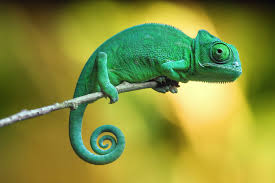
记忆方法
将“chameleon”分解为“chame”和“lion”。想象一只狮子在模仿(“chame”暗示变化)周围环境的颜色,就像变色龙一样。这种方法通过将单词与一个生动的形象联系起来,帮助你记忆这个词的含义。
以上内容由AI生成, 仅供参考和借鉴
中文词源
chameleon 变色龙
cham, 同human, 土,人。-leon, 同lion, 狮子。字面意思即土狮子。
英语词源
- chameleon (n.)
- mid-14c., camelion, from Old French caméléon, from Latin chamaeleon, from Greek khamaileon "the chameleon," from khamai "on the ground" (also "dwarf"), akin to chthon "earth" (see chthonic) + leon "lion" (see lion). Perhaps the large head-crest on some species was thought to resemble a lion's mane. The classical -h- was restored in English early 18c. Figurative sense of "variable person" is 1580s. It formerly was supposed to live on air (as in "Hamlet" III.ii.98).
权威例句
- 1. Like a chameleon, he could merge unobtrusively into the background.
- 他就像一条变色龙,可以神不知鬼不觉地隐藏在背景中间。
- 2. The chameleon changes colour to match its surroundings.
- 变色龙变换颜色以适应环境.
- 3. The chameleon adapts to its surroundings by changing color.
- 变色蜥蜴用变色来适应环境.
- 4. The chameleon's skin replicates the pattern of its surroundings.
- 变色龙的皮肤可随环境的模式而改变颜色.
- 5. Anna: It changed colours, like chameleon, it uses the jungle.
- 安娜: 它会变色, 像变色龙同样, 用丛林作掩护.